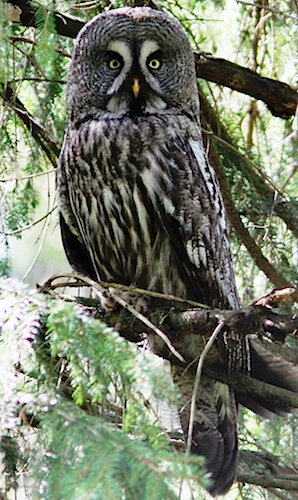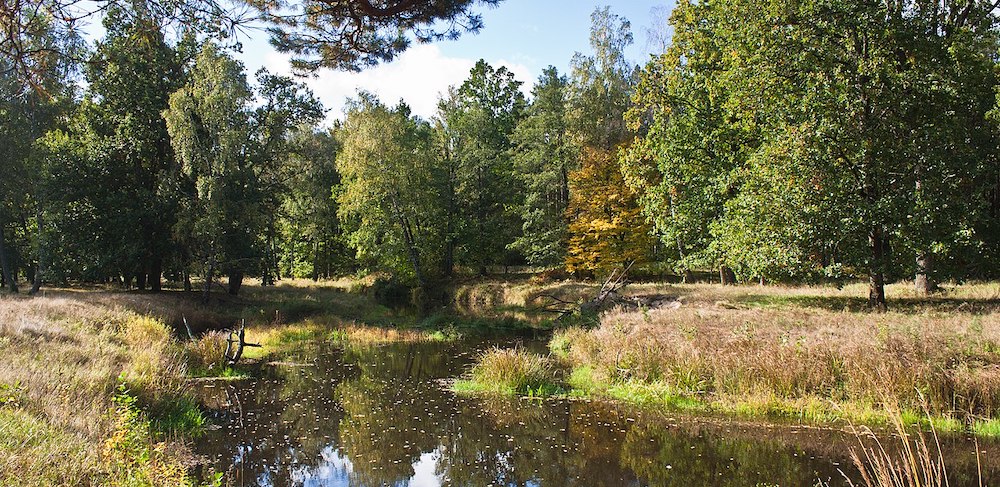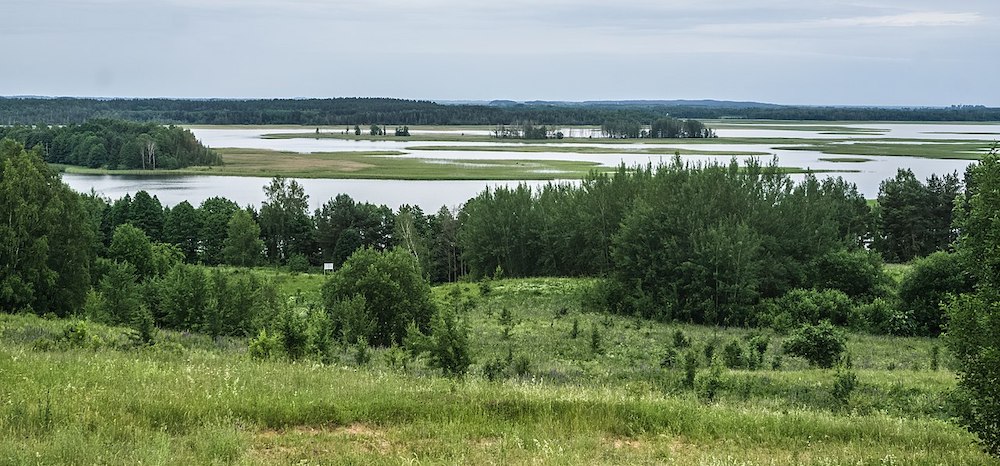Republic of Belarus

Belarus is a landlocked country in Eastern Europe. It is bordered by Russia to the east and northeast, Ukraine to the south, Poland to the west, and Lithuania and Latvia to the northwest. It spans an area of 207,600 km2 (80,200 square miles) with a population of around nine and half million people. Minsk is the capital and largest city with two million inhabitants. Belarus is relatively flat and contains large tracts of marshy land and forty percent of the country is forested. The country lies within two ecoregions: Sarmatic mixed forests and Central European mixed forests and has a hemi-boreal climate. It has many streams and as many as 11,000 lakes. Three major rivers run through the country: the Neman, the Pripyat, and the Dnepr. The Neman flows westward towards the Baltic sea and the Pripyat flows eastward to the Dnepr; the Dnepr flows southward towards the Black Sea. Belarus’s highest point is Dzyarzhynskaya Hill at just 1,130 feet; the country’s average elevation being 525 feet above sea level.
The climate ranges from harsh winters, with average January temperatures at −6 °C to cool and moist summers with an average temperature of 18 °C. The average annual rainfall is between 22 and 28 inches. The country experiences a yearly transition from a continental climate to a maritime climate.

Ubort River, Polesie Region – ©Borkia, CC BY-SA 3.0 via Wikimedia Commons
About 70% of the radiation from neighbouring Ukraine’s 1986 Chernobyl nuclear disaster entered Belarusian territory, and about a fifth of Belarusian land (principally farmland and forests in the southeastern provinces such as Polesie) continues to be affected by radiation fallout. The United Nations and other agencies have aimed to reduce the level of radiation in affected areas, especially through the use of caesium binders and rapeseed cultivation, which are meant to decrease soil levels of caesium-137.
Birding Belarus
Changes had made the country more accessible to birders including needing no visa for visits of less than a week. However, with its closeness to Russia and Ukraine, most western governments advise against travel there. We do not recommend going it alone. A number of companies still offer organised birding tours, and there is more safety in numbers.
Much of Belarus remains unspoilt with a similar avifauna to Poland and much less urbanisation. It is rural and abounds with wildlife that is scarce in many parts of Europe and the wilder areas have lynx, elk, wolves, wild boar, beavers and a variety of deer and smaller mammals with re-introduced European bison. There are five large national parks: Belovezhskaya Pushcha, Berezinsky Biosphere Reserve, Braslav Lakes, Narochansky & Pripyatsky. Some of the forests are undisturbed ancient woodland and other areas managed for timber still housing many species just hanging on elsewhere.

Braslav Lakes – ©Laveatein, CC BY-SA 4.0 via Wikimedia Commons
There is also the very large Polesie State Radio-ecological Reserve effected by the fallout from Chernobyl disaster. As studies have shown wildlife has flourished as it has been largely undisturbed with many villages abandoned.
For those joining organised tours to Belarus there are some terrific birds to see including ‘megas’ like Azure Tit, lekking Great Snipe, Great Grey Owls and Aquatic Warblers and a whole lot more such as Greater Spotted Eagle, Hazel Grouse, Western Capercaillie, Black Grouse, Terek Sandpiper, Ural, Tengmalm’s and Eurasian Pygmy Owls, Eurasian Three-toed and White-backed Woodpeckers, and Citrine Wagtail, to name just a few.
-
Servech Mire
Satellite ViewIt has recently been reported that the largest colony of aquatic warblers in the world is in Zvanec Mire IBA Other species: Spotted Eagle - 1-2 pairs, Spotted Crake 1000-4000, Corncrake, Eagle Owl, Savi's Warbler (1500-3000 pairs), Grasshopper Warbler (100-200 pairs).
-
Number of bird species: 355
(As of March 2025)National Bird: White Stork Ciconia ciconia
-
Avibase
PDF ChecklistThis checklist includes all bird species found in Belarus , based on the best information available at this time. It is based on a wide variety of sources that I collated over many years. I am pleased to offer these checklists as a service to birdwatchers. If you find any error, please do not hesitate to report them. -
Wikipedia
Annotated ListThis is a list of the bird species recorded in Belarus. The avifauna of Belarus include a total of 352 species. -
eBird
PDF ChecklistThis checklist is generated with data from eBird (ebird.org), a global database of bird sightings from birders like you. If you enjoy this checklist, please consider contributing your sightings to eBird. It is 100% free to take part, and your observations will help support birders, researchers, and conservationists worldwide.
-
Birds of Europe, North Africa, and the Middle East
| Photographic Guide | By Frédéric Jiguet & Aurélien Audevard | PUP | 2017 | Paperback | 447 pages, 2200 colour photos, colour distribution maps | ISBN: 9780691172439 Buy this book from NHBS.com -
Collins Bird Guide
| By Lars Svensson | Harper Collins | Edition 3 | 2023 | Paperback | 478 pages, 4000+ colour illustrations, 700 colour distribution maps | ISBN: 9780008547462 Buy this book from NHBS.com -
Directory of Important Bird Areas in Belarus
| (Terytoryi, Vazhnyia Dlia Ptushak u Belarusi: Kataloh) | By SV Levy | Riftur | 2015 | Hardback | 151 pages, b/w photos, colour illustrations, colour maps, colour tables | Out of Print | ISBN: 9789859031694 Buy this book from NHBS.com

Collins Bird Guide
AndroidThe Collins Bird Guide App provides everything you need to identify a species quickly and learn about it thoroughly.
Collins Bird Guide
Apple iOS |Collins Bird Guide 4+ A field guide to Europe NatureGuides Ltd. Designed for iPadReserves-
*Protected areas of Belarus
InformationSatellite ViewNational Parks, Biosphere Reserves etc. -
NP Belovezhskaya Pushcha
InformationSatellite Viewis a national park within parts of the Brest Region (Kamyanyets District and Pruzhany District) and Grodno Region (Svislach District) in Belarus adjacent to the Polish border. It is a preserved part of the UNESCO WHS Białowieża Forest, the last primaeval forest fragment of the European woodlands that once stretched across the European Plain. It is home to a large population of European bison, the continent's heaviest land animals. The border between the two countries runs through the forest with the Białowieża National Park on the Polish side of the border. Since May 2015 there has been a visa-free regime within the forest for hikers and cyclists at the Pererov-Białowieża border crossing. -
NP Braslaw Lakes
InformationSatellite ViewBraslaw Lakes is one of the four national parks in Belarus. It is a unique ecosystem with a number of lakes and a large area of pine forests. It has a total area of about 700 km2 (270 sq mi). Of the rare species listed in the Belarusian Red Book, the area is the home of the badger, lynx, brown bear, and swan. The swan was almost extinct in this area but now inhabits the Braslav lakes. Other native species include the black stork, common crane, silver seagull, willow grouse, and dunlin. The lakes of Braslav are rich with different kinds of fish. Pike, eels, perch, bream & tench are widespread. Also widespread are boar, roe deer, squirrel, brown and white hare, fox, raccoon, wolf, pine marten, otter, and mink. -
NP Narаchanski (Narochansky)
InformationSatellite ViewMammal species occurring in the park include red deer, raccoon dog, European badger, marten, and otter; fish species include common bream, silver bream, and crucian carp.The national park also includes 218 species of birds, including bittern, osprey and common crane. -
NP Pripyat Marshes
InformationSatellite ViewPripyatsky National Park or Pripyat National Park is a natural reserve in Gomel Region, Belarus. It was founded in 1996 for preservation of natural landscapes around the Pripyat River from which it takes its name. Much of the park's area is occupied by turf swamps. Pripyatsky National Park is home to 51 species of mammals, including elk, wild boar, red deer, European badger, and Eurasian lynx. -
NR Polesie State Radioecological Reserve
InformationSatellite ViewA nature reserve in the Polesie region of Belarus, which was created to enclose the territory of Belarus most affected by radioactive fallout from the Chernobyl disaster. The reserve adjoins the Chernobyl Exclusion Zone in Ukraine. -
Wetlands
WebsiteSatellite ViewThe convention entered into force in Belarus on 25 August 1991. Belarus currently has 26 sites designated as Wetlands of International Importance (Ramsar Sites), with a surface area of 765,617 hectares.
Sightings, News & Forums-
eBird
SightingseBirding This Month
Guides & Tour Operators-
APB Wetland Centre
Tour OperatorAPB Wetland Centre is a daughter company of APB-BirdLife Belarus, the largest non-governmental conservation organisation in Belarus. APB works for nature protection together with over 6,000 members, volunteers and supporters. It has identified 53 Important Bird Areas and due to our efforts most of those are now under protection by the State. APB Wetland Centre organises birding and wildlife tours to a variety of exciting wildlife reserves in Belarus. We prepare tours for beginners and experts with the emphasis on seeing rare birds and wildlife, experiencing the beauty of the country. -
BirdFinders
Tour OperatorThis exciting new tour to one of the least-known Eastern European destinations includes visiting several beautiful National Parks including Pripyatsky (a famous World Heritage Site), Bielaviežškaja Pušča (the larger eastern extension of Białowieza ancient forest in Poland) and Sporaŭski Reserve, home to 50% of the world’s Aquatic Warblers. We also have an excellent chance of finding one of Europe’s most difficult birds, Azure Tit. All this will be experienced with friendly people in beautiful surroundings. -
BirdQuest
Tour OperatorBELARUS – Europe’s Last Great Birding Frontier -
Branta Tours
Tour Operator -
Ecotours
Tour OperatorBelarus will most probably become one of the prime birding destinations in Europe. This country that is the Eastern neighbour of Poland is second to none. The variety of birds that includes several highlight species very rarely seen in other parts of Europe is only one aspect. Imagine roads taking you through ancient forests, hundreds of meandering rivers, the biggest marshes and fens of the continent, while you hardly meet any traffic or even people… -
NatureTrek
Tour OperatorA land locked country in Eastern Europe, it borders five countries, including Poland to the west and Russia to the north-east. Minsk is the capital city. Belarus is a low-lying country that has over 1,000 lakes and large tracts of primary forest which provide refuge for many species of mammals and birds. -
Travelling Naturalist
Tour OperatorThis little-visited, landlocked country delivers truly striking wildlife and birding holidays. Belarus is an excellent destination for seeing European bison, which roam the country’s ancient primeval forests.
Trip Reports-
2018 [05 May] - Ann & Trevor Jones
PDF Report...In the reedbeds, we had great views of Citrine Wagtail, Bluethroat, Sedge Warbler, and Whinchat. Most surprising of all was a Corncrake... -
2018 [05 May] - Nick Athanas
PDF ReportThe Azure Tit shown above was the favorite trip bird for most of the group, but a few other highlights included a vociferous Tawny Owl, immaculate Smew, displaying Great Snipe and Eurasian Woodcock, a confiding Eurasian Nightjar, and all ten of the possible woodpeckers. -
2018 [05 May] - Nik Borrow
PDF ReportThis incredible tour was our fourth visit to the well-kept secret that is Belarus. This land-locked country in eastern Europe nestles between Russia in the northeast, Ukraine to the south, Poland to the west and Lithuania and Latvia to the northwest and was at least certainly ‘off the radar’ to many ecotourists until relatively recently. There are no words to really prepare the visitor for the apparent remoteness of the country; over 40% is covered in beautiful natural forests and the open areas are comprised of expansive marshes and rural countryside interspersed with the odd town. -
2019 [05 May] - Barrie Cooper
PDF Report...we saw some fantastic wildlife including nine species of woodpeckers, five species of owl, European Bison and Europe’s most endangered bird – Aquatic Warbler. Belarus is the best European country to see Azure Tits and we saw a pair nest building on our first morning...
Other Links
Fatbirder - linking birders worldwide...
Skip to content
